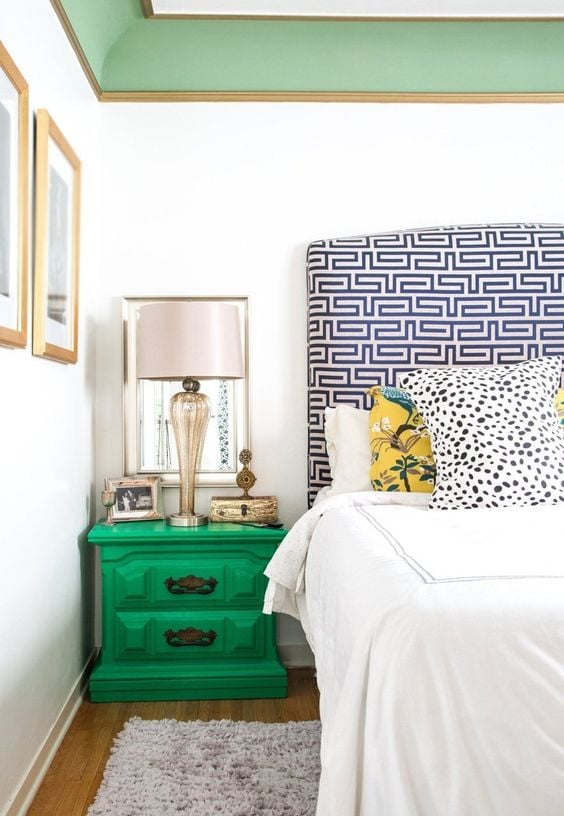Higher sleep quality - with a luxurious touch
Online reviews of hotels are rife with tales of bad nights’ sleep and distracting noise levels.
A bad night in a hotel is something that guests will remember long after they’ve departed, so it’s understandable that so much research is being done on increasing sleep quality through good design.
A key finding that’s coming out of all of this is that soft surfaces and textiles are very important when it comes to sound absorption. Hard surfaces reflect sound waves: soft surfaces, such as draperies, rugs and cushions, all help against noise pollution.
It’s easy to add unobtrusive but sleep-enhancing elements to the design of sleeping spaces, such as sound-absorbing wall panels, upholstered headboards, weighted blankets and blackout curtains.
Check out maximize your interior design with triple the fabrics
An upholstered headboard is the added extra your guests are missing
Upholstered headboards add a touch of luxe to any interior design style as well as softening the edges of the noise level. Other benefits have nothing to do with sound and everything to do with comfort.
Upholstered headboards are undeniably much more enjoyable to lean against than hard, wooden headboards or, worse, no headboard at all.
As you can imagine, a cushy surface is a boon to bed-time readers and watchers of late-night TV. It’s a simple and cost-effective way to enhance the overall experience of your guests.
Creation of cozy spaces leads to a good night’s rest
It’s been argued that the rise of minimalist interior design is tightly linked to the crash of 2008, and it’s not hard to see why: bare, white walls and minimal furniture speak to much leaner times. Minimalist spaces might be very nice to look at, but, let’s be honest, they’re not welcoming to live in.
The world has moved on in the past ten years though, and we’re seeing a recoil against minimalism that’s been a long time coming.
Interior design is now looking towards a warmer, eclectic feel for interiors with much more personality than minimalism can afford.
Looking for more to read in the hospitality industry? Head straight to 6 restaurant interior design trends you need to know about for 2019
We’re seeing this not only in residential interiors, but also branching out into the explosion of boutique hotels, and hotel design as a whole.
Championed by interior styling icons such as Dorothy Draper and Billy Haines, Hollywood Regency (sometimes called Regency Moderne) is roaring back into fashion with all its glitz, glam and ultra-opulence.
Developed after the Great Depression, it’s quite fitting to see this styling trend returning now to the forefront.
Take a leaf from the Hollywood Regency lookbook to add a hint of intimate enchantment to your bedroom interiors.
Keep your interiors low key tranquil with an eclectic feel
Hollywood Regency can be very full-on, though. What we’re seeing is less of a total embrace of the trend, and more of a nod of the head to it. Understated glam is a hard line to follow, but designers around the world are achieving this look by narrowing their focus to a few key pieces. For bedroom interior design, many designers are focusing on upholstered headboards as a result.
As we said in an earlier post, go maximalist by thinking minimalist. Just because you want to ‘oomph’ up your hotel room interiors doesn’t mean you need to go all in on the velvet animal prints.
Speaking of velvet….
We’ve seen spaces embracing the return of this Hollywood-style allure, but with the volume turned a little bit lower by neutral palettes.
Take a look at beautiful examples of this styling below: each one has a bit of volume and drama but mellows the entire scene out with neutral colourscapes and natural textures.
Along with Hollywood Regency, Feng Shui is back too
Headboards aren’t the only thing designers are reconsidering.
Placement of beds in hotel rooms and personal spaces can make or break the flow of the interior, and this has been coming more into focus in recent months.
Naturally, the placement of a bed will vary based on the size of the room you are working with, as well as the placement of windows and doors.
Which brings us to feng shui, the ‘command’ position, and upholstered headboards.
Yes, feng shui is back.
The ‘command’ position in feng shui describes an area with view of the door (not in line with it) and without your back to a window. In other words, you command the room: you can see who comes in and out, and your back isn’t exposed to the window either.
Whether you go with feng shui guidelines or not, placing a bed in view of the door, without a window behind the headboard, can understandably increase its occupants’ feeling of security and peace of mind.
Plus, since there are no sharp edges or outlines, an inviting, upholstered headboard does not detract from your feng shui goals in allowing the flow of energy to move freely around the interior space.
“A good headboard will create strong and supportive energy for your bed, which provides for better sleep, as well as an overall sense of being supported in life. A weak headboard - or an absence of a headboard altogether - will do the opposite.” - Rodika Tchi
Tranquillity begins in the bedroom
From Hollywood Regency to bed placement, experiential design in the hospitality industry have never been more under the microscope.
Inviting interiors with a touch of eclectic personality are thoroughly back in vogue, and what makes this even better is that these warm, cozy interiors improve sleep quality. In today’s hectic world, a good night’s sleep can benefit you greatly, and the hospitality industry is paying attention to this more than ever.











